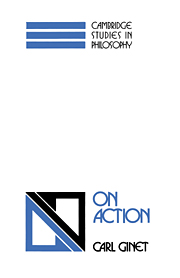2 - VOLUNTARY EXERTION OF THE BODY
Published online by Cambridge University Press: 05 June 2012
Summary
The action of opening a door consists in the agent's voluntarily exerting parts of her body – her arm and hand, let us suppose – in such a way that that action (the voluntary exertion of the body) causes the door to open. It is possible, in principle, to open a door without using any voluntary exertion to do so. Conceivably, a person's brain could be so wired to a door that merely by mentally saying “Open sesame!”, and without any exertion of her body, she could cause the door to open. There are ways in which one can act on or with one's body without engaging in any voluntary exertion. (For example, sexual arousal can be produced by forming appropriate mental images.) And our lives are filled with mental actions – mentally saying things, forming mental images, and the like – that, though they may affect the body, do not in themselves and in virtue of their very notion include any bodily event, whether voluntary exertion or other. But it is nonetheless true that actions done by voluntarily exerting the body, together with voluntary exertions themselves, comprise most of the actions that we have occasion to consider explicitly. Our voluntary exertions of our bodies are a central and especially important sort of action. We must understand what they are if we are to understand most sorts of actions we talk about.
- Type
- Chapter
- Information
- On Action , pp. 23 - 44Publisher: Cambridge University PressPrint publication year: 1990



